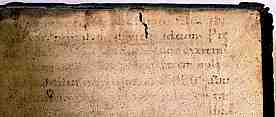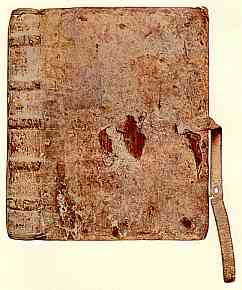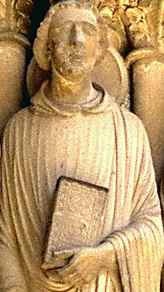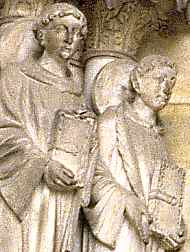





If you are looking at this page without frames, there is more information about medieval writing to be found by going to the home page (framed) or the site map (no frames).
| Bookbindings | |||||
| Bookbindings serve the purpose of protecting the pages and helping to keep them in order, but as the external covering of a book, they also form something of the conception of what a book should be. The majority of books from the medieval era are not in their original bindings. These have either succumbed to wear and tear, or the the post-medieval owners of books have had them rebound to fit in with their conception of how a book should be, and how it should fit into their library. There are a significant number of books surviving in original bindings, and there are also depictions of books in other art forms. | |||||
 |
The most common type of bookbinding was made on a base of two rectangular wooden boards which were laced together through the backs of the quires of parchment that made up the codex. | ||||
| A late medieval book in its original binding, a 15th century volume of the works of Cicero, by permission of the University of Tasmania Archives. | |||||
| The whole was covered in leather which was fastened down on the inside of the covers with pastedowns made from parchment. It is not so unusual to find that these pastedowns, and other reinforcing strips inside the binding, have been made from re-used sheets of parchment from older books. | |||||
 |
A pastedown from the above volume, made from parchment still displaying 12th century wrting, by permission of the University of Tasmania Archives. | ||||
| Most bookbindings were not heavily decorated, but the leather was sometimes stamped with patterns or metal bosses were attached. At the end of the medieval era, the leather was sometimes carved in designs. The book was commonly held closed with a leather strap and metal clasp. Sometimes they were equuipped with hefty metal bosses on the front and back covers, and while these look very tough and defensive, they were probably to allow very heavy books to be stored on their sides or to protect the covers while standing on a lectern. | |||||
| The Dscriptorium website illustrates a 15th century tooled leather binding with metal bosses on a volume of the Chronique de Pierre le Prestre from the Bibliothèque Municipale d'Abbeville (MS 94). Bookbindings are illustrated for all the entries in the e-codices - Virtual Manuscript Library of Switzerland website. Princeton University Library has an online exhibition of Hand Bookbindings from medieval times to modern. | |||||
| Medieval binding of the Reading Abbey cartulary (British Library, Egerton 3031). |
 |
||||
| The example at right shows the standard plain type of medieval bookbinding. The damaged leather covering has peeled back in places to reveal the boards beneath. The closing strap is still attached. | |||||
 |
A portal figure on the south doorway of Chartres cathedral holds a book with a decorative cover. | ||||
| Saints are often depicted in medieval art holding a book. The 13th century figure of St John the Apostle holds a book which is depicted in some detail with an elaborate tooled leather cover. The closing strap is visible. In such a situation there is no doubt that a book would be depicted as a book should be, with all its proper attributes. | |||||
 |
At left, two saints on the south portal of Laon Cathedral hold books with decorative tooled edges and large clasps. |
 |
|||
| At right, St John the Evangelist holds a book with decorative bindings and a large clasp in a 15th century stained glass window the the church of All Saints North Street, York. | |||||
If you are looking at this page without frames, there is more information about medieval writing to be found by going to the home page (framed) or the site map (no frames). |
|||||